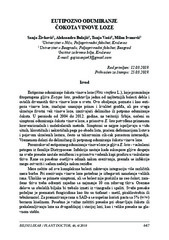Приказ основних података о документу
Eutypa dieback of grapevine
Eutipozno odumiranje čokota vinove loze
| dc.creator | Živković, Sanja | |
| dc.creator | Bulajić, Aleksandra | |
| dc.creator | Vasić, Tanja | |
| dc.creator | Ivanović, Milan | |
| dc.date.accessioned | 2020-12-17T22:24:38Z | |
| dc.date.available | 2020-12-17T22:24:38Z | |
| dc.date.issued | 2018 | |
| dc.identifier.issn | 0354-6160 | |
| dc.identifier.uri | http://aspace.agrif.bg.ac.rs/handle/123456789/4840 | |
| dc.description.abstract | The eutypa dieback of grapevine (Vitis vinifera L.), caused by phytopathogenic fungus Eutypa lata, is one of the most severe diseases of trunk and other woody tissues of grapevine in the world. This disease, also known as the grapevine eutyposis, significantly reduces yield and quality of grapes, but primarily reduces the life span of the vines, causing partial or complete dying of grapevine. During 2004-2012, symptoms of dieback of grapevine were observed in Serbia and E. lata presence was confirmed by conventional and molecular identification methods. Symptoms first appear in the form of tiny, chlorotic and necrotic spots on the periphery of the leaf, followed by deformation of the leaves and the appearance of shortened shoots, often with the so-called zigzag growth of internodes. Subsequently, partial or complete dying of the grapevine occurs. The causal agent of eutypa dieback is E. lata - a vascular pathogen from the Diatrypaceae family. The infection occurs when ascospores reach fresh wounds formed by pruning, and in the presence of water droplets penetrate into the vascular tissue. Wounds are particularly sensitive immediately after pruning, although infections can occur seven weeks after the pruning. Eutyposis disease control requires integration of several different control measures. When pruning the grapevine, large scale wounding should be avoided. Pruned parts from diseased plants should be taken out of the vineyard and burned. If the symptoms are present, but the disease has not spread to the whole vine, the infected tissue should be pruned off together with at least 10 cm of healthy tissue. Fresh cuts should be preferably coated with fungicides such as thiophanate-methyl, pyraclostrobin or tebuconazole. In USA, paste with 5% (w/w) boric acid is successfully used for the coating of wounds. It is especially important to protect cuts during the restoration of grapevines or grafting grapevine on the two-year-old and the older grapevine, as well as in the large cuts inflicted in the main trunk. In the USA (California), it is recommended to conduct pruning as late as possible, just before bud swelling. Preventive measures include selection of less sensitive varieties and removal of potential disease hosts near the vineyard. Breeding forms of grapevine with lower stems and mixed pruning are also recommended. | en |
| dc.description.abstract | Eutipozno odumiranje čokota vinove loze (Vitis vinifera L.), kojе prouzokuje fitopatogena gljiva Eutypa lata, predstavlja jednu od najštetnijih bolesti debla i ostalih drvenastih tkiva vinove loze u svetu. Ovо oboljenje, poznato i kao eutipoza vinove loze, značajno smanjuje prinos i kvalitet grožđa, ali pre svega skraćuje životni vek vinove loze, izazivajući delimično ili potpuno odumiranje čokota. U peroiodu od 2004 do 2012. godine, na teritoriji Srbije, uočeni su simptomi odumiranja čokota vinove loze, a prisustvo E. lata potvrđeno primenom konvencionalnih i molekularnih metoda. Simptomi se najpre ispoljavaju u vidu sitnih, hlorotičnih i nekrotičnih pega po obodu lista, praćeni deformacijom listova i pojavom skraćenih lastara, često sa takozvanim cik-cak porastom internodija. Vremenom dolazi do delimičnog ili potpunog odumiranja čokota vinove loze. Prouzrokovač eutipoznog odumiranja vinove loze je gljiva E. lata - vaskularni patogen iz familije Diatrypaceae. Infekcija nastaje kada askospore gljive dospeju na sveže preseke nastale rezidbom i u prisustvu vodenih kapi prodiru u vaskularno tkivo. Rane su posebno osetljive odmah nakon orezivanja, premda se infekcije mogu ostvariti i sedam nedelja nakon rezidbe. Mere zaštite od ove kompleksne bolesti zahtevaju integraciju više različitih mera borbe. Pri orezivanju vinove loze potrebno je izbegavati nanošenje velikih rana. Ukoliko se primete simptomi, ali se bolest nije proširila na ceo čokot, zaraženo tkivo treba odrezati zajedno sa najmanje 10 cm zdravog tkiva. Orezane delove sa obolelih biljaka bi trebalo izneti iz vinograda i spaliti. Sveže preseke poželjno je premazati fungicidima kao što su tiofanat - metil, piraklostrobin ili tebukonazol. Za premazivanje rana u SAD-a se uspešno koristi pasta sa 5% (w/w) bornom kiselinom. Posebno je važno zaštititi preseke pri obnavljaju čokota ili prekalemljivanju loze na dvogodišnjoj i starijoj lozi, kao i velike preseke na glavnom stablu. U SAD (Kaliforniji) preporučuje se što kasnija rezidba, ako je moguće pred samo bubrenje pupoljaka. Preventivne mere uključuju izbor manje osetljivih sorti i uklanjanje potencijalnih domaćina prouzrokovača u blizini vinograda. Za preventivu se preporučuje i izbor nekog od uzgojnih oblika koji podrazumevaju formiranje čokota sa niskim stablom - mešovita rezidba. | sr |
| dc.publisher | Univerzitet u Novom Sadu - Poljoprivredni fakultet - Departman za zaštitu bilja i životne sredine "dr Pavla Vukasovića", Novi Sad | |
| dc.relation | info:eu-repo/grantAgreement/MESTD/Integrated and Interdisciplinary Research (IIR or III)/46008/RS// | |
| dc.relation | info:eu-repo/grantAgreement/MESTD/Integrated and Interdisciplinary Research (IIR or III)/43001/RS// | |
| dc.rights | openAccess | |
| dc.source | Biljni lekar | |
| dc.subject | grapevine | en |
| dc.subject | dieback | en |
| dc.subject | Eutypa lata | en |
| dc.subject | control | en |
| dc.subject | vinova loza | sr |
| dc.subject | odumiranje čokota | sr |
| dc.subject | Eutypa lata | sr |
| dc.subject | zaštita | sr |
| dc.title | Eutypa dieback of grapevine | en |
| dc.title | Eutipozno odumiranje čokota vinove loze | sr |
| dc.type | article | |
| dc.rights.license | ARR | |
| dc.citation.epage | 658 | |
| dc.citation.issue | 6 | |
| dc.citation.other | 46(6): 647-658 | |
| dc.citation.rank | M52 | |
| dc.citation.spage | 647 | |
| dc.citation.volume | 46 | |
| dc.identifier.fulltext | http://aspace.agrif.bg.ac.rs/bitstream/id/3349/4837.pdf | |
| dc.identifier.rcub | https://hdl.handle.net/21.15107/rcub_agrospace_4840 | |
| dc.type.version | publishedVersion |


